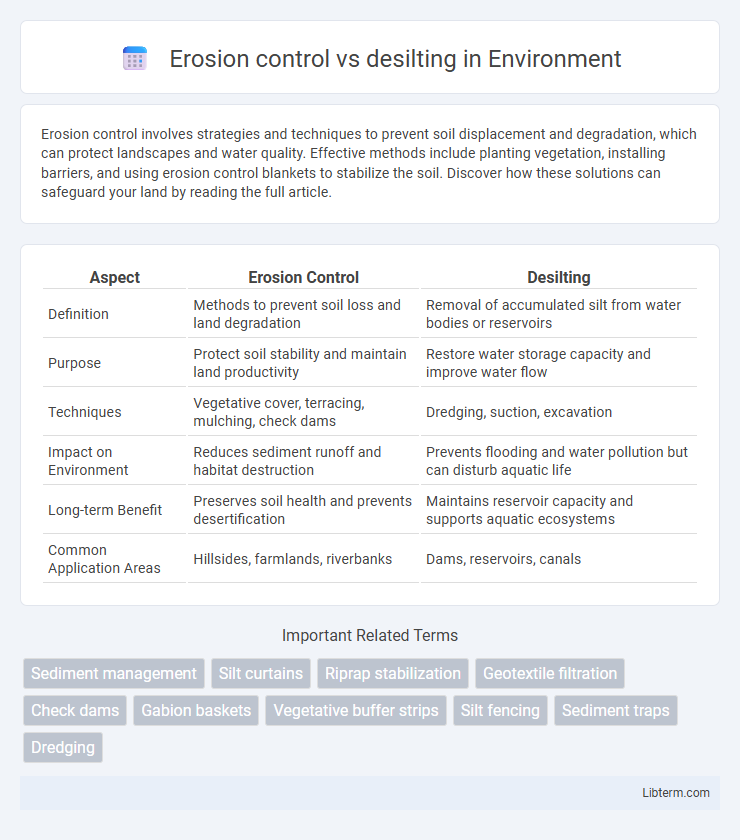Erosion control involves strategies and techniques to prevent soil displacement and degradation, which can protect landscapes and water quality. Effective methods include planting vegetation, installing barriers, and using erosion control blankets to stabilize the soil. Discover how these solutions can safeguard your land by reading the full article.
Table of Comparison
| Aspect | Erosion Control | Desilting |
|---|---|---|
| Definition | Methods to prevent soil loss and land degradation | Removal of accumulated silt from water bodies or reservoirs |
| Purpose | Protect soil stability and maintain land productivity | Restore water storage capacity and improve water flow |
| Techniques | Vegetative cover, terracing, mulching, check dams | Dredging, suction, excavation |
| Impact on Environment | Reduces sediment runoff and habitat destruction | Prevents flooding and water pollution but can disturb aquatic life |
| Long-term Benefit | Preserves soil health and prevents desertification | Maintains reservoir capacity and supports aquatic ecosystems |
| Common Application Areas | Hillsides, farmlands, riverbanks | Dams, reservoirs, canals |
Understanding Erosion Control and Desilting
Erosion control involves implementing techniques such as vegetation planting, riprap installation, and retaining walls to prevent soil displacement and maintain land integrity. Desilting focuses on removing accumulated sediments from water bodies like rivers, lakes, and reservoirs to restore water flow and storage capacity. Understanding the distinction highlights erosion control as a preventative measure, while desilting is a corrective action addressing sediment buildup.
Key Differences Between Erosion Control and Desilting
Erosion control involves strategies such as vegetation planting, use of geotextiles, and retaining walls to prevent soil loss and stabilize land, whereas desilting focuses on removing accumulated sediments from water bodies to restore depth and flow capacity. Erosion control aims to protect the land surface from degradation over time, while desilting targets the maintenance of waterways and reservoirs by clearing silt deposits. The primary difference lies in erosion control preventing sediment generation, whereas desilting deals with sediment accumulation management.
Causes and Effects of Soil Erosion
Soil erosion is primarily caused by water runoff, wind, deforestation, and poor agricultural practices, which remove the topsoil layer and degrade land fertility. Erosion control methods such as terracing, planting cover crops, and building check dams help reduce soil loss and prevent sediment deposition in water bodies. Desilting involves removing accumulated sediments from reservoirs and canals, addressing the effects of erosion by restoring water storage capacity and preventing flooding.
Importance of Desilting in Water Management
Desilting plays a crucial role in water management by removing accumulated sediments from reservoirs, canals, and water bodies, thereby restoring their capacity and improving water flow. Effective desilting reduces the risk of flooding, enhances irrigation efficiency, and supports aquatic ecosystems by maintaining water quality. Unlike erosion control, which prevents soil loss, desilting addresses sediment buildup, making both essential yet distinct components of sustainable water resource management.
Popular Erosion Control Methods
Popular erosion control methods include the use of vegetation, such as planting grass and trees, which stabilizes soil and reduces runoff. Structural techniques like terracing, retaining walls, and geotextiles are commonly employed to prevent soil displacement on slopes and riverbanks. These measures are proactive strategies, whereas desilting focuses on removing accumulated sediments from water bodies to restore flow capacity and prevent flooding.
Techniques and Tools for Desilting
Desilting techniques involve the removal of accumulated silt from water bodies using tools such as dredgers, suction pumps, and excavators, which restore reservoir capacity and improve water flow. Manual desilting employs hand tools like shovels and buckets for small-scale operations, while mechanical desilting relies on hydraulic dredgers and draglines for efficiency in large water bodies. Proper selection of desilting equipment based on sediment type and site conditions enhances sediment management and promotes sustainable water resource maintenance.
Environmental Impacts: Erosion vs. Sediment Accumulation
Erosion control mitigates soil loss and reduces sediment runoff into water bodies, preserving aquatic habitats and preventing water pollution. Desilting removes accumulated sediments from reservoirs and rivers, restoring water flow and reducing risks of flooding and habitat disruption caused by sediment build-up. Effective management of erosion and sediment accumulation enhances ecosystem stability and improves water quality.
Cost Comparison: Erosion Control vs. Desilting
Erosion control typically involves higher upfront costs due to the installation of measures like retaining walls, vegetation, or geotextiles, but it reduces long-term expenses by preventing soil loss and structural damage. Desilting costs vary based on the scale and frequency of sediment removal but often entail recurring operational expenses for equipment, labor, and disposal of dredged materials. Evaluating lifecycle costs reveals erosion control as a more cost-effective solution for sustainable land and water management compared to the repeated expenses associated with desilting.
Best Practices for Sustainable Land and Water Management
Erosion control techniques such as contour plowing, terracing, and the use of cover crops effectively reduce soil loss by stabilizing the land and maintaining soil structure. Desilting, involving the removal of accumulated sediments in water bodies, enhances water flow and reservoir capacity, preventing flooding and maintaining aquatic health. Implementing integrated land and water management practices that combine erosion control and periodic desilting ensures long-term sustainability by protecting soil fertility and preserving water resources.
Choosing the Right Solution: When to Control Erosion or Desilt
Selecting between erosion control and desilting hinges on the specific environmental challenge: erosion control is essential when soil loss and sediment displacement threaten land stability and water quality, employing techniques such as vegetation, geotextiles, and retaining structures. Desilting becomes necessary when sediment accumulation in water bodies, reservoirs, or drainage systems impairs flow capacity and aquatic ecosystems, requiring mechanical sediment removal or dredging. A thorough site assessment measuring sediment sources, transport rates, and depositional zones ensures the optimal intervention, balancing long-term land preservation with water resource management.
Erosion control Infographic

 libterm.com
libterm.com